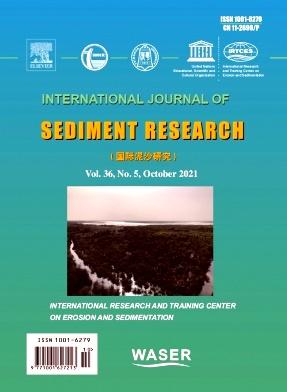通过降雨模拟评估地中海水库集水区的入渗和侵蚀速率
IF 3.7
2区 环境科学与生态学
Q2 ENVIRONMENTAL SCIENCES
引用次数: 0
摘要
水库集水区的土地利用和植被类型对土壤入渗和径流的水文过程有重要影响。它们也作为侵蚀过程的驱动因素或约束因素。所有这些过程都会影响到达水库的水和沉积物的数量,并影响水库的功能。本研究的主要目的是通过试验降雨模拟和多元统计分析来提高对西班牙东南部这些过程的认识。结果表明:森林的平均入渗速率是灌丛地的1.06倍,是橄榄作物的1.07倍(分别为280.52、265.02和262.08 mm/h),平均地表径流量是灌丛地的1.57倍,橄榄作物的2.41倍(分别为20.81、32.58和50.24 mm/h)。橄榄林(518.43 g/L)比森林(94.61 g/L)高5.48倍,比灌丛(176.48 g/L)高2.94倍。土壤性质和母质可能比不同植被类型对研究变量的影响更重要。此外,根系和作物耕作方式有利于入渗,这将趋于平衡所分析的变量值;但这需要在未来的研究中得到证实。所得结果对地中海地区水库集水区的植被覆盖和土壤管理具有重要意义。此外,目前的研究提供了一个机会,可以更具体地研究到达水库的沉积物的来源,而不是薄片和细沟侵蚀。本文章由计算机程序翻译,如有差异,请以英文原文为准。
Assessment of infiltration and erosion rates in Mediterranean reservoirs’ catchments through rainfall simulation
The land use and vegetation type of a reservoir's catchment substantially affect the hydrological processes of soil infiltration and runoff. They also act as drivers or constraints for erosive processes. All the previous processes influence the amount of water and sediment that reach the reservoir and affect its functioning. This study is mainly aimed to improve the knowledge of these processes in southeastern Spain by means of experimental rainfall simulation and multivariate statistical analysis. The results show that the mean infiltration rate is 1.06 times higher in forests than in shrublands and 1.07 times higher than in olive crops (280.52, 265.02, and 262.08 mm/h, respectively), with mean surface runoff consequently 1.57 times lower in forests than in shrublands and 2.41 times lower than in olive crops (20.81, 32.58, and 50.24 mm/h). Likewise, the sediment concentration in the runs is 5.48 times higher in olive groves (518.43 g/L) than in forests (94.61 g/L) and 2.94 times higher than in shrublands (176.48 g/L). Soil properties and parent material might have a more important effect on the studied variables than the different vegetation types. Furthermore, root systems and the use of tillage on crops could favor infiltration, which would tend to equalize the values of the variables analyzed; but this needs to be demonstrated in future research. The results obtained are of interest for vegetation cover and soils management in reservoirs’ catchments in Mediterranean areas. Furthermore, the current research provides an opportunity to study more specifically the origin of the sediment that reaches the reservoirs, beyond sheet and rill erosion.
求助全文
通过发布文献求助,成功后即可免费获取论文全文。
去求助
来源期刊
CiteScore
6.90
自引率
5.60%
发文量
88
审稿时长
74 days
期刊介绍:
International Journal of Sediment Research, the Official Journal of The International Research and Training Center on Erosion and Sedimentation and The World Association for Sedimentation and Erosion Research, publishes scientific and technical papers on all aspects of erosion and sedimentation interpreted in its widest sense.
The subject matter is to include not only the mechanics of sediment transport and fluvial processes, but also what is related to geography, geomorphology, soil erosion, watershed management, sedimentology, environmental and ecological impacts of sedimentation, social and economical effects of sedimentation and its assessment, etc. Special attention is paid to engineering problems related to sedimentation and erosion.

 求助内容:
求助内容: 应助结果提醒方式:
应助结果提醒方式:


